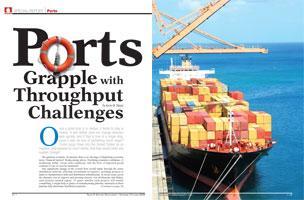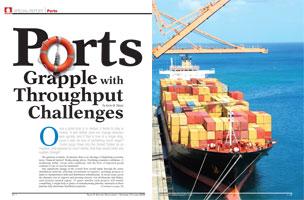

Once a great ship is in motion, it tends to stay in motion. It will neither slow nor change direction very quickly. And if that is true of a single ship, could it also be true of something much larger? Could cargo flows into the United States be so massive, and possess so much inertia, that they would resist any sudden change?
The question is timely. At present, there is no shortage of dispiriting economic news. Financial turmoil. Rising energy prices. Declining consumer confidence. A weakening dollar. Given such conditions, will the flow of imported goods continue to rise or even be sustained?
Any significant change in the overall flow would ripple through the entire distribution network, affecting investments in logistics, including projects to improve transportation links and distribution infrastructure. In recent years, given the dramatic rise in imports and growing anxiety over bottlenecks and delays, such projects seemed urgent. To guess whether such projects will remain compelling, it might help to glance at manufacturing patterns, inasmuch as these patterns help determine distribution patterns.
“Can the U.S. Bring Jobs Back from China?”
In a June 2008 article, BusinessWeek focused on China, a conspicuous source of U.S. imports. BusinessWeek asked, “Can the U.S. Bring Jobs Back from China?” The article built a persuasive case that the manufacturing operations that have already relocated to China will probably stay there, despite the erosion in the “China price,” the 40 to 50 percent cost advantage held by Chinese manufacturers.* This advantage is not what it once was, thanks to soaring energy costs, which are pushing up production costs. Rising shipping costs and wages play a role, too.
With a sinking dollar making U.S.-manufactured goods cheaper abroad, there is hope that U.S. manufacturers will take advantage of a less appealing China price, and seize the opportunity to boost U.S. exports. Alas, BusinessWeek soberly points out that Chinese manufacturers no longer have to compete on the basis of price. Increasingly, they compete on the basis of technological sophistication and rising productivity. In addition, they appear to benefit from clustering effects. Chinese manufacturing is more than a collection of isolated factories. It consists of self-reinforcing networks of related suppliers and support services.
A simple cost calculation might serve to justify moving a single manufacturing operation. But moving an industry cluster is more complicated and takes more time. In a sense, clustering offers a measure of protection, but without protectionism – which is why clustering strategies are so attractive to U.S. development officials. (Incidentally, these strategies are regularly reviewed, industry by industry, in this publication.)
Thus, thanks in part to clustering effects in manufacturing, distribution patterns will remain uncomplicated by dramatic increases in U.S. exports, at least for the time being. There may well be exceptions. Individual factories and even selected sectors may fill more orders from around the world. But these changes represent relatively small trade volumes. They do not significantly augment or detract from traffic totals, which are dominated by imports.
Early in 2008, some ports were reporting decreases in trade volumes of as much as 7 percent. While the current economic slowdown may be short-lived, at least compared to the time scales associated with shifts in manufacturing capacity, the possibility remains that when trade volumes start growing again, the growth rates will be relatively moderate.
Even with moderate growth in trade volumes, existing logistics capacity may prove inadequate. Several studies conclude that while the growth rate for world trade may decrease, it will still exceed overall economic growth. In addition, imports may move in fits and starts. Already there are definite peaks. And shipyards are building even larger cargo ships, which means more cargo per delivery, increasing the likelihood that ports will be intermittently glutted with cargo. Peaks may become even sharper. During these peaks, there could be longer and more costly delays, even if yearly volumes increase hardly at all.
Avoiding and Reducing Delays
For ports in North America, the immediate goal is to avoid or reduce delays. Achieving this goal has become easier, given the current slowdown. However, coping with long-term growth will remain a challenge.
Amelioration strategies do not always entail ambitious infrastructure upgrades. For example, the Port of Los Angeles and the Port of Long Beach began expanding the hours of port operations. This solution, called the OffPeak program, is run by PierPass, a not-for-profit company. In June 2008, PierPass announced that OffPeak had diverted more than nine million truck trips from peak daytime traffic since the program’s start three years ago. The program, which created nighttime and Saturday shifts at Los Angeles/Long Beach, eased bottlenecks in the ports, reduced gridlock on area freeways, and curtailed air pollution from idling traffic.
Not only can import flows be spread out over time, as with the PierPass example, they can be spread out over space. For example, shippers and distributors look for opportunities to diversify entry points. The motivations go beyond the need to cope with persistent (if less spectacular) growth. The ability to direct cargo to alternative ports makes it easier to deal with hard-to-predict disruptions such as labor strife, natural disasters, industrial accidents and terrorist attacks.
After the 10-day shutdown of Los Angeles/Long Beach in 2002, shippers and distributors were more inclined to diversify. And smaller ports, such as the Port of Tacoma, soon enjoyed rapid growth. Located on Commencement Bay, a deep-water harbor in Southern Puget Sound, the Port of Tacoma has 2,400 acres that are used for shipping terminal activity and warehouse, distributing and manufacturing. More than 70 percent of the Port’s international import container cargo heads east via rail.
In 2007, the Port of Tacoma handled more than $36 billion in annual trade and nearly 2 million TEUs (Twenty-foot Equivalent container Units). These numbers qualify the Port of Tacoma as the nation’s seventh largest container port.
The Georgia Ports Authority (GPA) is also vying for more container traffic. It is already benefiting from current market conditions, which favor exports, because its’ inland barge operations facilitate trade in agricultural goods. And yet the GPA’s Port of Savannah is also the nation’s fourth busiest and fastest growing container terminal. In May 2008, the GPA announced that the Garden City Terminal in Savannah expected to post a record-breaking year with more than 2.2 million TEUs handled in the first 10 months of fiscal year 2008, a 19 percent increase compared with 2007.
GPA has strategic partnerships with many international ports, such as the Suez Canal Authority, Shanghai International Port Group, Sydney Ports Corporation, Panama Canal Authority and Port of Shimizu. In 2007, 67 percent of GPA’s total increase in trade, or an additional 296,989 TEUs, was via the Suez Canal. “In the last 18 months, we have doubled the number of our Suez services, even in the midst of a U.S. economic downturn,” said the GPA’s Executive Director Doug J. Marchand. “Our Suez trade will only continue to accelerate in the years ahead.”
Eventually, when the economy grows stronger and traffic flow increases, diversion strategies may no longer suffice. All spare capacity will have been exploited. All slack will have been taken up. Then, increasing emphasis will be placed on efforts to build new capacity or effectively add capacity via technological innovation.
Curiously, analysts’ projections of future traffic levels typically show little change in relative rankings among ports. Indeed, increases are seen across the board, with proportions of the total held by individual ports remaining much the same. The implication is that these ports are all subject to similar constraints. Any port, however well managed, may accommodate only so much growth before certain familiar tradeoffs become apparent.
The essential tradeoff is between proximity to the port and the cost of real estate. If a transload facility, an import warehouse, or a distribution center locates close to a port, it tends to lower drayage and demurrage costs, but real estate maybe more expensive, or sufficient space may be unavailable. (A large facility, covering perhaps 500,000 square feet, would require a 25-acre parcel.)
In one of the examples cited above, the Port of Tacoma, growth was stimulated by the desire for a west-coast alternative to Los Angeles/Long Beach. But within a few years, this growth also squeezed vacancy rates and boosted prices for industrial land near the port. In addition, some nearby communities, overwhelmed by traffic and unimpressed by tax income and jobs creation, started limiting the size of new warehouses or instituting moratoriums on their construction.**
What happened next is a development familiar to ports everywhere – companies started looking farther afield for cheap, plentiful real estate and more appreciative neighbors.
Another option available near certain ports is the chance to develop nearby real estate more intensively. For example, in the Portfields Initiative, a joint project of the Port Authority of New York and New Jersey and the New Jersey Development Authority, brownfield and other underutilized sites are being repurposed. The Portfields Initiative assists developers interested in building intermodal facilities on designated shovel-ready sites. Properties must be a minimum of 24 acres in area and able to accommodate at least 350,000 square feet of cargo distribution space. To date, 17 sites have been designated. The ultimate goal is the redevelopment of 1,000 acres of property in the Port District over the next 10 years.
Another innovation is the inland port, which has various incarnations. Instead of hugging a port, inland ports position themselves beside important railways or roadways. Some, like the Tejon Industrial Complex located to the north of Los Angeles, lack rail connections, and seem best suited for local distribution, provided backhauling does not reintroduce traffic to urban areas surrounding coastal ports. Import centers, which consolidate cargo from various origins, may also be appropriate. At the Tejon center, 2.5 million square feet of distribution space is already available. The center expects to add another 20 million square feet.
Other inland ports emphasize their rail connections. Those most expressly designed to relieve congestion at coastal ports include so-called agile ports. These provide for rail transfer of unsorted inland containers from a vessel to the inland point. While such inland ports may increase throughput at coastal ports, they do involve extra handling, and thus extra costs. (This solution is distinct from on-dock rail solutions that involve sorting at the marine terminal.)
In a study commissioned by the Southern California Association of Governments, the feasibility of a commuter shuttle concept was explored. This concept involved the use of rail shuttles and shared line capacity to serve not one large inland terminal, but several small, commuter-style inland terminals. While noting the concept had merit, the study suggested its implementation was impractical. The study added that the eventual development of port links to inland logistics parks might be more realistic.
Increasing Throughput
It is likely that the most intense development of the agile port concept and other innovations may well occur at Los Angeles/Long Beach, especially since more traditional options, such as locating facilities within the Inland Empire, is becoming increasingly difficult. Los Angeles/Long Beach not only handles more containers than any other U.S. port, it also grapples with stringent environmental demands. If these ports find ways to increase throughput while also minimizing emissions, traffic, and noise, other ports might emulate these innovations. Ports obliged to be considerate of their neighbors – especially ports near residential areas – may prove eager students.
*Engardio, P. Can the U.S. Bring Jobs Back from China? BusinessWeek. June 19, 2008.
** Shevory, K. The Hunt for Deepwater Ports. New York Times. June 23, 2006.
